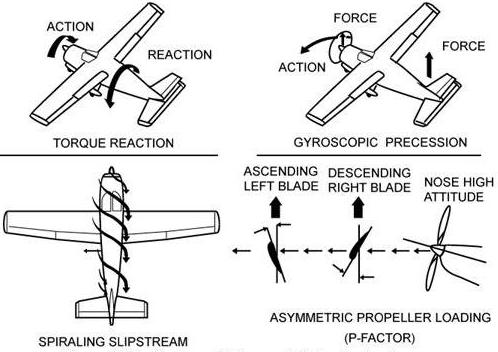1-9
TURNING TENDENCY (TORQUE EFFECT)
By definition, “torque” is a force, or combination of forces,
that produces or tends to produce a twisting or rotating motion of an airplane.
An airplane propeller spinning clockwise, as seen from the rear, produces
forces that tend to twist or rotate the airplane in the opposite direction,
thus turning the airplane to the left. Airplanes are designed in such a
manner that the torque effect is not noticeable to the pilot when the airplane
is in straight-and-level flight with a cruise power setting.
| The effect of torque increases in direct proportion to
engine power, airspeed, and airplane attitude. If the power setting is
high, the airspeed slow, and the angle of attack high, the effect of torque
is greater. During takeoffs and climbs, when the effect of torque is most
pronounced, the pilot must apply sufficient right rudder pressure to counteract
the left-turning tendency and maintain a straight takeoff path.
Several forces are involved in the insistent tendency of an airplane
of standard configuration to turn to the left. All of these forces are
created by the rotating propeller. How they are actually created varies
greatly from one explanation to the next. |

Figure 1-18.—Factors which cause left-turning
tendency.
|
Individual explanation of these forces is perhaps the best approach
to understanding the reason for the left-turning tendency.
The four forces are:
• Torque Reaction
• Spiraling Slipstream
• Gyroscopic Precession
• Asymmetric Propeller Loading (“P” Factor)
